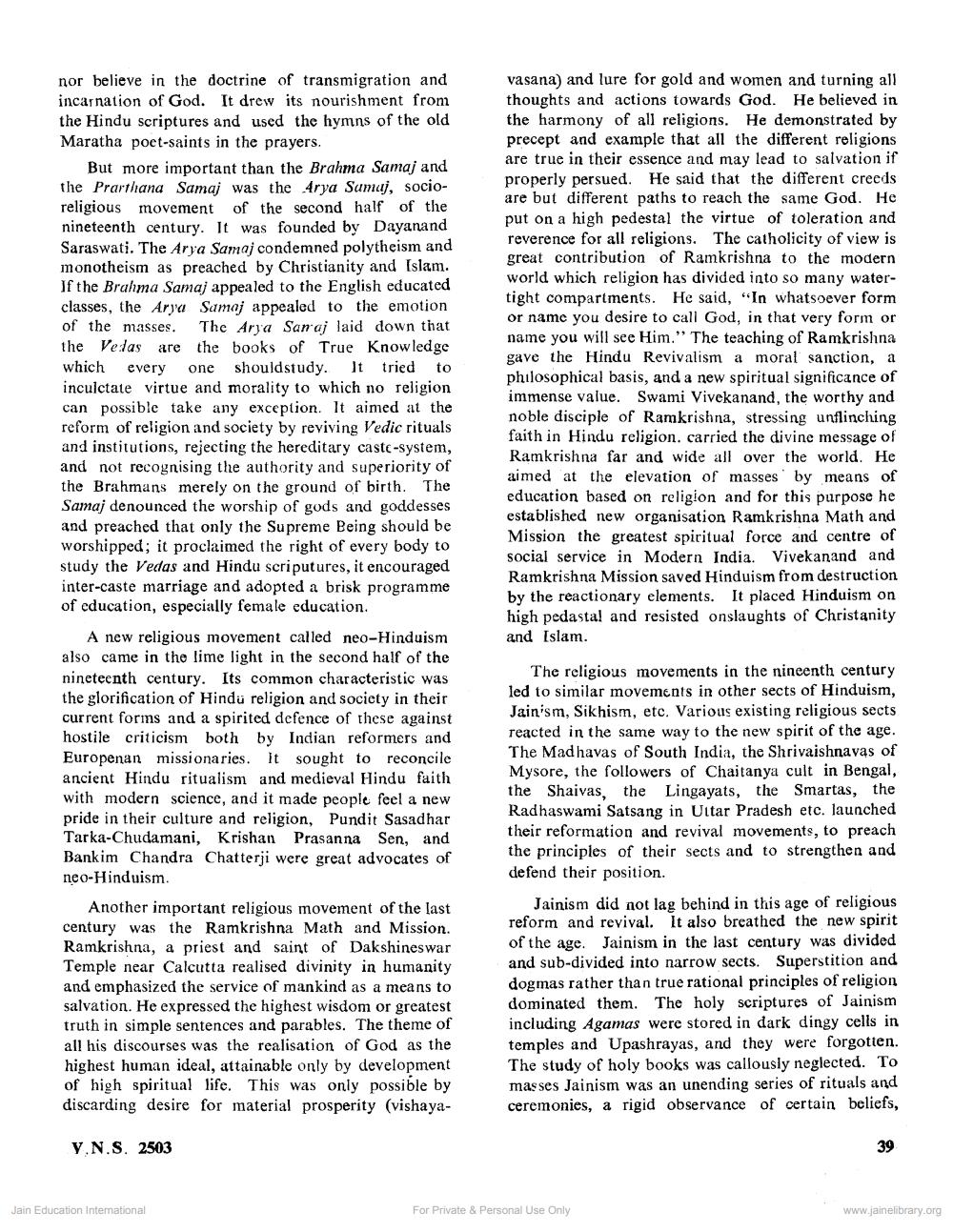Book Title: Rajendrasuri A Reformer and Revivalist Author(s): B N Luniya Publisher: Z_Rajendrasuri_Janma_Sardh_Shatabdi_Granth_012039.pdf View full book textPage 2
________________ nor believe in the doctrine of transmigration and incarnation of God. It drew its nourishment from the Hindu scriptures and used the hymns of the old Maratha poet-saints in the prayers. But more important than the Brahma Samaj and the Prarthana Samaj was the 4rya Sumuj, socioreligious movement of the second half of the nineteenth century. It was founded by Dayanand Saraswati. The Arya Samaj condemned polytheism and monotheism as preached by Christianity and Islam. If the Brahma Samaj appealed to the English educated classes, the Arya Samaj appealed to the emotion of the masses. The Arya Samaj laid down that the Vedas are the books of True Knowledge which everyone shouldstudy. It tried to inculctate virtue and morality to which no religion can possible take any exception. It aimed at the reform of religion and society by reviving Vedic rituals and institutions, rejecting the hereditary castc-system, and not recognising the authority and superiority of the Brahmans merely on the ground of birth. The Samaj denounced the worship of gods and goddesses and preached that only the Supreme Being should be worshipped; it proclaimed the right of every body to study the Vedas and Hindu scriputures, it encouraged inter-caste marriage and adopted a brisk programme of education, especially female education. vasana) and lure for gold and women and turning all thoughts and actions towards God. He believed in the harmony of all religions. He demonstrated by precept and example that all the different religions are true in their essence and may lead to salvation if properly persued. He said that the different creeds are but different paths to reach the same God. He put on a high pedestal the virtue of toleration and reverence for all religions. The catholicity of view is great contribution of Ramkrishna to the modern world which religion has divided into so many watertight compartments. He said, "In whatsoever form or name you desire to call God, in that very form or name you will see Him." The teaching of Ramkrishna gave the Hindu Revivalism a moral sanction, a philosophical basis, and a new spiritual significance of immense value. Swami Vivekanand, the worthy and noble disciple of Ramkrishna, stressing unflinching faith in Hindu religion. carried the divine message of Ramkrishna far and wide all over the world. He aimed at the elevation of masses by means of education based on religion and for this purpose he established new organisation Ramkrishna Math and Mission the greatest spiritual force and centre of social service in Modern India. Vivekanand and Ramkrishna Mission saved Hinduism from destruction by the reactionary elements. It placed Hinduism on high pedastal and resisted onslaughts of Christanity and Islam. A new religious movement called neo-Hinduism also came in the lime light in the second half of the nineteenth century. Its common characteristic was the glorification of Hindu religion and society in their current forms and a spirited defence of these against hostile criticism both by Indian reformers and Europenan missionaries. it sought to reconcile ancient Hindu ritualism and medieval Hindu faith with modern science, and it made people feel a new pride in their culture and religion, Pundit Sasadhar Tarka-Chudamani, Krishan Prasanna Sen, and Bankim Chandra Chatterji were great advocates of neo-Hinduism. Another important religious movement of the last century was the Ramkrishna Math and Mission. Ramkrishna, a priest and saint of Dakshineswar Temple near Calcutta realised divinity in humanity and emphasized the service of mankind as a means to salvation. He expressed the highest wisdom or greatest truth in simple sentences and parables. The theme of all his discourses was the realisation of God as the highest human ideal, attainable only by development of high spiritual life. This was only possible by discarding desire for material prosperity (vishaya The religious movements in the nineenth century led to similar movements in other sects of Hinduism, Jainism, Sikhism, etc. Various existing religious sects reacted in the same way to the new spirit of the age. The Madhavas of South India, the Shrivaishnavas of Mysore, the followers of Chaitanya cult in Bengal, the Shaivas, the Lingayats, the Smartas, the Radhaswami Satsang in Uttar Pradesh etc. launched their reformation and revival movements, to preach the principles of their sects and to strengthen and defend their position. Jainism did not lag behind in this age of religious reform and revival. It also breathed the new spirit of the age. Jainism in the last century was divided and sub-divided into narrow sects. Superstition and dogmas rather than true rational principles of religion dominated them. The holy scriptures of Jainism including Agamas were stored in dark dingy cells in temples and Upashrayas, and they were forgotten. The study of holy books was callously neglected. To masses Jainism was an unending series of rituals and ceremonies, a rigid observance of certain beliefs, Y.N.S. 2503 39 Jain Education International For Private & Personal Use Only www.jainelibrary.orgPage Navigation
1 2 3
